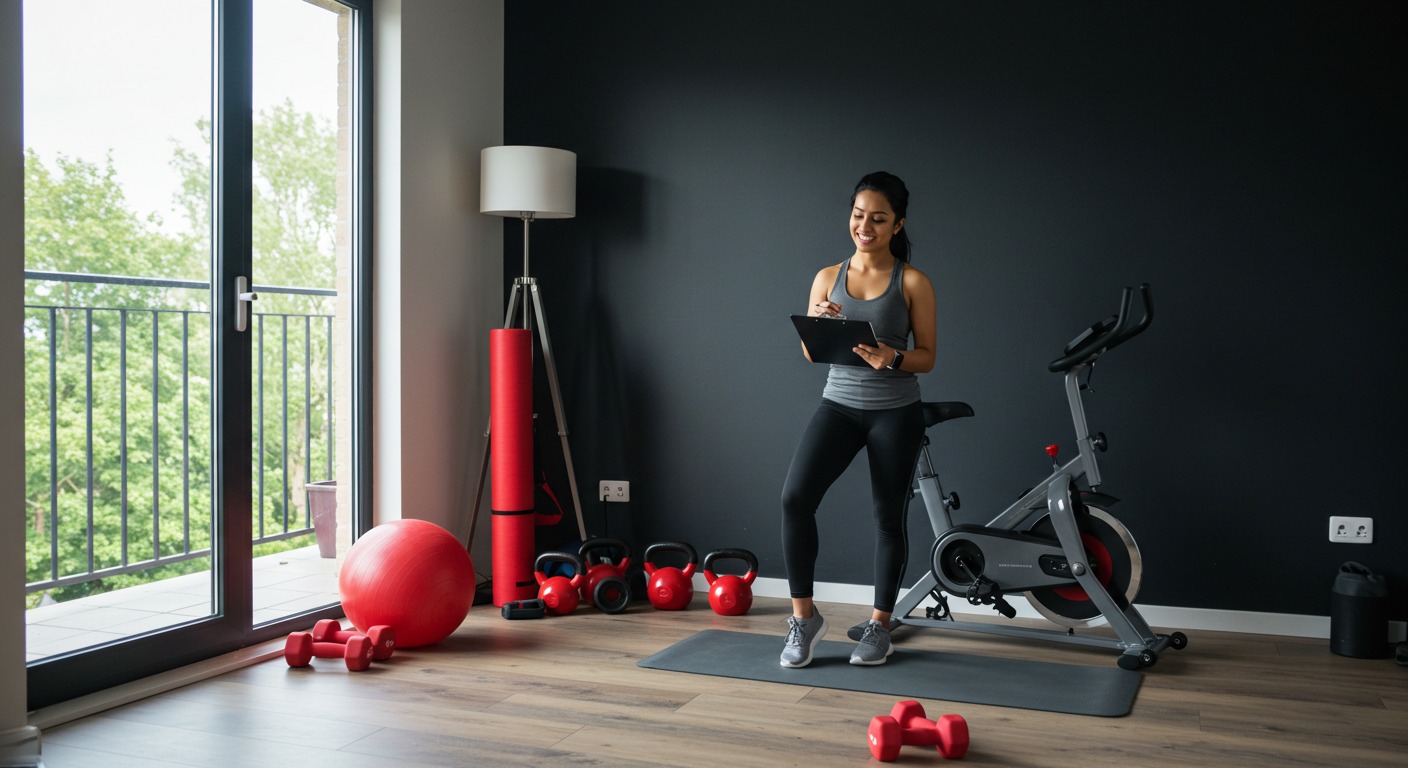Disclosure Information
This blog contains affiliate links. If you make a purchase through one of these links, our team may earn a commission at no extra cost to you. Learn more. Thanks for your support!
Measuring fitness progress transforms vague goals into concrete achievements. Whether you’re building muscle, losing weight, or improving cardiovascular health, systematic tracking provides the data you need to optimize your workouts and stay motivated.
Why Track Your Fitness Journey
Consistent monitoring reveals patterns that casual observation might miss. Progress tracking helps identify which exercises deliver results and which need adjustment. Without measurement, you’re essentially exercising blind.
Research shows that people who track their fitness activities are 23% more likely to achieve their goals compared to those who don’t monitor progress (Source: American Journal of Preventive Medicine). This data-driven approach eliminates guesswork from your fitness routine.
Regular assessment also prevents plateaus by highlighting when your body adapts to current routines. Early detection of stagnation allows for timely program modifications.
Essential Metrics to Monitor
Body Composition Changes
Body weight alone tells an incomplete story. Muscle weighs more than fat, so scale numbers can mislead during body recomposition phases. Consider tracking body fat percentage alongside weight measurements.
Circumference measurements provide valuable insights into muscle growth and fat loss. Key areas include waist, hips, chest, arms, and thighs. Monthly measurements reveal changes that daily weigh-ins might obscure.
Performance Improvements
Strength gains manifest through increased weight lifted, more repetitions completed, or improved form quality. Document your personal records across major compound movements like squats, deadlifts, and bench presses.
Cardiovascular fitness improvements appear as faster times, longer distances, or lower resting heart rates. Track these metrics consistently to gauge aerobic capacity enhancements.
Recovery and Wellness Indicators
Sleep quality, energy levels, and mood fluctuations reflect your body’s adaptation to training stress. Poor recovery often precedes injury or burnout, making these wellness metrics crucial for long-term success.
Types of Fitness Tracking Tools
Traditional Manual Methods
Workout logs remain the foundation of fitness tracking. Paper journals or simple spreadsheets capture exercise details, weights used, and sets completed. This method costs nothing and works anywhere.
Photography provides visual progress documentation that numbers can’t convey. Take consistent photos under similar lighting conditions, wearing the same clothing, and from identical angles.
| Method | Cost | Accuracy |
|---|---|---|
| Paper logs | Free | High |
| Photos | Free | Visual only |
| Measurements | $5-20 | Very high |
Digital Fitness Apps
Smartphone applications revolutionized fitness tracking accessibility. Popular options include MyFitnessPal for nutrition, Strava for running, and Strong for strength training. Most apps sync across devices automatically.
Fitness apps typically offer exercise libraries, progress charts, and social features. Premium versions often include advanced analytics and personalized coaching recommendations. Free versions handle basic tracking needs adequately.
Studies indicate that 67% of fitness app users maintain their exercise routines longer than non-users (Source: Journal of Medical Internet Research). The convenience and motivation features explain this higher adherence rate.
Wearable Technology
Fitness trackers and smartwatches monitor activity levels, heart rate, and sleep patterns continuously. Popular brands include Fitbit, Apple Watch, Garmin, and Samsung Galaxy Watch.
These devices excel at tracking daily activity, providing gentle reminders to move, and monitoring workout intensity. Advanced models offer GPS tracking, heart rate variability analysis, and recovery recommendations.
| Device Type | Price Range | Best For |
|---|---|---|
| Basic trackers | $50-150 | Step counting |
| Smartwatches | $200-800 | All activities |
| Specialty GPS | $300-600 | Running/cycling |
Professional Assessment Tools
Body composition analyzers like DEXA scans provide the most accurate measurements of muscle mass, bone density, and fat distribution. These professional services typically cost $100-200 per scan.
Fitness professionals offer movement screenings, strength assessments, and cardiovascular testing. While expensive, these evaluations provide baseline measurements and identify potential injury risks.
Gym Equipment Integration
Modern gym equipment often includes built-in tracking capabilities. Cardio machines record workout duration, distance, and calories burned. Some equipment syncs with fitness apps automatically.
Heart rate monitors worn during workouts provide real-time intensity feedback. This data helps optimize training zones and ensures appropriate workout difficulty levels.
Choosing the Right Tracking Method
Consider Your Goals
Weight loss goals benefit from calorie tracking apps combined with regular weigh-ins and measurements. Focus on tools that monitor both dietary intake and physical activity levels.
Strength training progress requires detailed workout logs capturing weights, sets, and repetitions. Consider apps designed specifically for resistance training with exercise libraries and progression tracking.
Evaluate Your Tech Comfort Level
Technology-averse individuals might prefer simple paper logs or basic fitness trackers. These methods provide essential data without overwhelming complexity or learning curves.
Tech-savvy users can leverage comprehensive apps, wearable devices, and cloud synchronization. These tools offer advanced analytics but require time investment to master their features.
Budget Considerations
Free options like smartphone apps and manual tracking methods work effectively for beginners. Paper logs cost virtually nothing and provide unlimited customization options.
Premium subscriptions and wearable devices offer convenience and advanced features. Consider whether the additional cost provides proportional value for your specific needs and goals.
Creating an Effective Tracking System
Establish Baseline Measurements
Document your starting point across all relevant metrics before beginning any new fitness program. This baseline provides context for future progress assessments.
Take initial photos, record body measurements, and test your current fitness levels. Baseline data serves as motivation during challenging periods when progress feels slow.
Set Measurement Schedules
Daily weigh-ins can cause unnecessary stress due to normal weight fluctuations. Weekly measurements provide more stable trend data without obsessive monitoring.
Monthly progress photos and circumference measurements capture slower changes that daily tracking might miss. Quarterly professional assessments offer comprehensive progress evaluations.
Track Multiple Data Points
Relying on single metrics creates an incomplete picture of your progress. Weight loss might not reflect muscle gain occurring simultaneously. Combine multiple measurement methods for comprehensive assessment.
Performance metrics, body composition changes, and wellness indicators together provide a complete progress picture. This holistic approach prevents discouragement when one metric temporarily stagnates.
Research shows that individuals tracking multiple metrics achieve 31% better results than those monitoring single variables (Source: International Journal of Behavioral Nutrition and Physical Activity). Comprehensive tracking improves decision-making and motivation.
Common Tracking Mistakes to Avoid
Obsessive Daily Monitoring
Checking metrics too frequently creates unnecessary stress and anxiety. Body weight fluctuates daily due to hydration, food intake, and hormonal changes. Focus on weekly trends instead.
Progress photos taken daily show minimal changes and can lead to discouragement. Monthly photos reveal meaningful transformations that daily comparisons obscure.
Ignoring Non-Scale Victories
Improvements in energy levels, sleep quality, and mood indicate successful fitness progress. These wellness improvements often occur before visible physical changes appear.
Strength gains, endurance improvements, and flexibility increases represent significant achievements. Don’t let scale obsession overshadow these important progress indicators.
Inconsistent Measurement Conditions
Take measurements under consistent conditions for accurate comparisons. Weigh yourself at the same time daily, preferably first thing in the morning after using the bathroom.
Body measurements should occur at the same anatomical landmarks using identical techniques. Inconsistent measurement methods create false progress readings and unnecessary confusion.
Staying Motivated Through Data
Celebrate Small Wins
Acknowledge incremental improvements rather than waiting for dramatic transformations. Adding five pounds to your squat or completing an extra push-up represents meaningful progress.
Milestone celebrations maintain motivation during long-term fitness journeys. Set mini-goals within larger objectives to create frequent success experiences and sustained enthusiasm.
Use Visual Progress Tools
Charts and graphs transform raw data into compelling visual stories. Most fitness apps generate automatic progress charts that highlight trends over time.
Before-and-after photo comparisons provide powerful motivation during difficult periods. These visual reminders demonstrate real changes that daily mirror checks might not reveal.
Share Your Progress
Social accountability increases adherence to fitness programs. Share your achievements with workout partners, online communities, or social media networks for additional motivation.
Progress sharing creates external accountability and often inspires others beginning their fitness journeys. This mutual support system strengthens commitment to long-term health goals.
Conclusion
Effective fitness tracking combines multiple measurement methods tailored to your specific goals and preferences. Whether you choose high-tech wearables or simple paper logs, consistency matters more than complexity.
Start with basic tracking methods and gradually add tools as your needs evolve. The best tracking system is the one you’ll actually use consistently over time.
Remember that fitness progress rarely follows a straight line. Expect plateaus, setbacks, and non-linear improvements. Your tracking data will help navigate these challenges and maintain long-term success.

